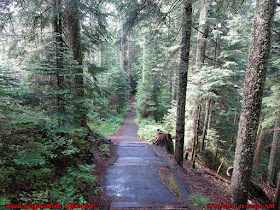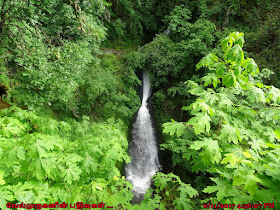Firelane 7 Springville Road Loop Hike
Forest Park is a public municipal park in the Tualatin Mountains west of downtown Portland, Oregon, United States. Stretching for more than 8 miles (13 km) on hillsides overlooking the Willamette River, it is one of the country's largest urban forest reserves.
In the central and
northern sections of vast Forest Park, numerous fire lanes and old road tracks
run from east to west down the slope of the Tualatin Hills. Before the Wildwood
Trail was built through here, these were the principal avenues of access. This
loop uses a Firelane 7 on the way down the slope and Springville Road on the
way back, both routes making use of ridge lines where you won't see a lot of
other visitors. Springville Road is an old wagon road that Tualatin Valley
farmers used to haul their produce up and over the hills to the Willamette
River. In between Firelane 7 and Springville, you'll hike along the more
popular Wildwood Trail, following contours in and out of gullies in secondary
forest. Look for forest wildflowers in spring and early summer and mushrooms in
the fall.
Hike Description
Walk down
Springville Road through a green gate. In about 30 yards, Firelane 7 peels off
to the right. The firelanes and roads in Forest Park are also used by mountain
bikers, so keep alert on this section of the hike. Big-leaf maple, red alder,
sword fern, salal, western red-cedar, Oregon grape, Douglas-fir, grand fir and
a few hemlock saplings make up the woodland here. Come to the Hardesty
Trail-Firelane 7 Junction and keep right. The trail rises briefly and passes
the junction with the Trillium Trail, which offers a shortcut to the Wildwood
Trail. To complete this loop, however, stay on Firelane 7 in an avenue of
alders and maples and then descend again. Keep right at the junction with the
Ridge Trail. The wide firelane levels and rises. Alders dominate here. Reach
the junction with Firelane 7A and stay right. This is also called the Oil Line
Road (part of Firelane 7). There are more evergreens on this section. Warning
signs declare a petroleum pipeline. Arrive at the Wildwood Trail-Firelane 7
Junction and go left.
Alders, maples,
cascara saplings and old stumps make up the woodland. The forest becomes young
hemlocks under Douglas-firs and maples. Sword fern, holly, and Oregon grape
make up the understory. Then enter deciduous groves of maple and alder with
thickets of salmonberry along the draws. Keep straight at the junction with
Firelane 7A. There are glimpses of the industrial area far below and always the
sounds of traffic and trains. The woods are very open in the winter on this
section as many of the trees are deciduous. Pass a pit next to the trail. Head
into a deep draw with cedars and drooping vine maples on a maidenhair-lined
trail. Cross a seasonal creek and then the trail heads gently up. Pass the
junction with the Ridge Trail. Descend on an old road bed and pass through a
grove of hemlock and cedar, crossing a seasonal creek on a footbridge. Then
hike under more hemlocks and cedars to arrive at the Wildwood-Hardesty Trail
Junction, where you go right.
Descend and cross
a creek; then pass the "Big Stump", a huge cedar stump with
springboard notches: this tree was brought down over 100 years ago. The
Hardesty is a wide, packed trail that loses altitude rather quickly. A creek
runs on your right. We come to the junction with Leif Erikson Drive, which is
very popular with runners and bikers, and go left at Milepost 9. Cedar, hemlock
and Douglas-fir predominate down here. Sword fern and inside-out flower verge
the road. Ivy crawls high up many of the conifers and carpets the forest floor.
On the left are some cement steps from a house that once stood here, a reminder
that, beginning in 1914, Leif Erikson Drive (then Hillside Drive) was platted
out as a subdivision. A damaged, feathery branched Arizona cypress, snapped off
about ten feet up, still survives here. Come to a Forest Park map sign and head
up Springville Road to the left. Note the occasional Pacific yew amongst the
other conifers. Soon come to the junction with the Wildwood Trail and cross it.
Pass an orange gate on your left and keep rising to the junction with Firelane
7, where you go right through the green gate to parking. Source: Oregon Hikers
·
Start
point: Springville Road Trailhead
·
Hike
Type: Loop
·
Distance:
4.9 miles
·
Elevation
gain: 1120 feet
·
Difficulty:
Easy
·
Seasons:
All year
·
Features:
Birding, Fall Colors, Wildflowers, Wildlife
·
This
trail connects with other trails: Wildwood Trail, Gasline Trail, Northwest
Springville Road, Ridge Trail, Old Firelane 7 and Trillium Trail.
How to Reach:
Northwest Firelane
7 Road is a hiking trail in Portland, Oregon. It is within Forest Park. Springville
Road Trailhead has Small parking lot and turn around which provides access to
Springville Road and Firelane 7. Springville is open to pedestrians, cyclists,
and equestrians; FL7 is open only to pedestrians and equestrians. Also nearby
are the Hardesty, Trillium, and Ridge Trails which are pedestrian access only.



















































